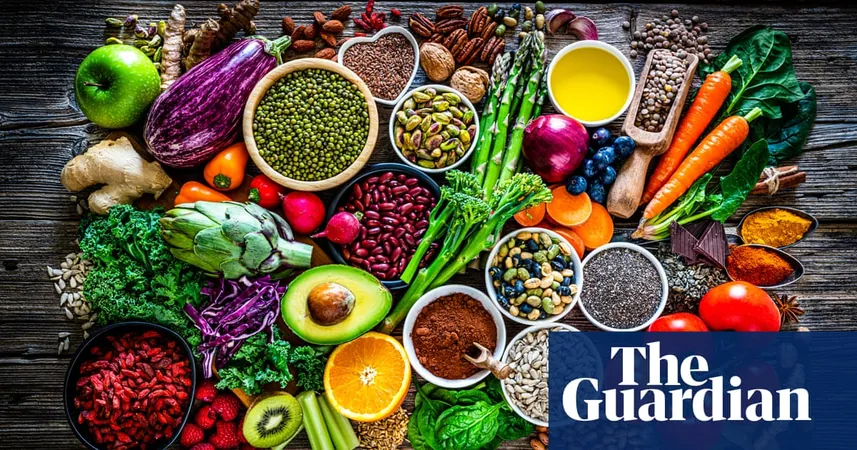
The Fibre Revolution: 30 Simple Ways to Boost This Essential Nutrient That Can Change Your Life!
2025-01-22
Author: Charlotte
Introduction
What’s the number one culprit behind diet-related health problems? Is it ultra-processed foods or maybe a surplus of salt, sugar, and fat? Surprisingly, research from a systematic review published in 2022 points to our inadequate intake of whole grains as the primary issue. These nutritional powerhouses are filled with B vitamins, folic acid, omega-3 fats, protein, antioxidants, and vital micronutrients, and most importantly, they're rich in fibre.
“Fibre often gets overlooked. It’s seen as dull and boring, tasting like cardboard to many. Plus, it's frequently associated with discomforting side effects like bloating and gas,” says Dr. Samantha Gill, a gastroenterology dietitian from the British Dietetic Association. With that kind of image, it’s no wonder that fibre intake is alarmingly low. In fact, most countries have set a daily fibre intake recommendation of 30 grams for adults, yet people consistently fall short. Data reveals that only 3% of Canadians, 5% of Americans, and 9% of UK residents meet these guidelines. And in Germany—the European leader in fibre consumption—intake averages only around 25 grams. “We have a significant fibre gap,” Gill points out, “with UK adults averaging just 19 grams per day.”
The Importance of Fibre
Fibre is a unique carbohydrate derived from plants and is abundant in whole grains, fruits, vegetables, nuts, seeds, herbs, spices, and legumes. Unlike other carbohydrates, fibre isn’t easily digested; it travels through the digestive tract without being broken down. Its most recognized benefit is its role in preventing constipation. “Certain types of fibre add bulk to stools, making them easier to pass,” Gill explains.
But the advantages of fibre reach far beyond regularity. A pivotal study published in 2019 indicated that a high-fibre diet could reduce the risk of heart disease, stroke, type 2 diabetes, and colon cancer by 16-24%. Moreover, a 2015 report from the Scientific Advisory Committee on Nutrition in the UK found that for every additional 7 grams of fibre consumed daily (equivalent to half a tin of baked beans), the risk of various noncommunicable diseases could be reduced by up to 9%. Recent findings also illustrate that fibre supports a healthy gut microbiome and even benefits brain health.
“The reason fibre can influence so many aspects of health is that it’s not just one type of substance,” says Gill. “Fibre is an umbrella term encompassing various types that interact differently within the body.”
Current Fibre Intake Challenges
Despite these impressive health benefits, fibre consumption in the UK has stagnated, according to Bridget Benelam, a communications manager for the British Nutrition Foundation. “Since the guidelines were updated in 2015, there’s been no progress in fibre intake. A shift could unlock numerous health advantages and foster a more sustainable diet.”
James Collier, co-founder of Huel and author of *Well Fed*, warns of a looming fibre crisis. “Let’s face it: fibre isn’t glamorous. In fitness circles, the buzz is always about protein. But we need to ask ourselves, when was the last time anyone asked if you had your fibre today? It’s fundamental to our well-being.” He adds, “Getting to 30 grams a day isn’t really that challenging—especially with a plant-rich diet.”
But is it truly attainable? A study highlighted obstacles to achieving the ideal 30-gram goal, including “a lack of awareness regarding the health benefits of fibre beyond digestive health” and "negative notions surrounding starchy foods," often wrongly labeled as fattening.
Dietary Trends and Recommendations
“Unfortunately, today’s diet is predominantly low in fibre,” Gill asserts. “In the UK, most diets are overly high in salt, sugar, and fat.” Alarmingly, only 27% of UK adults consume their recommended five daily servings of fruits and vegetables. However, there is a glimmer of hope—a chance to improve. “While we often focus on what to cut from our diets, promoting fibre intake can serve as an empowering message,” Benelam encourages.
One bright spot is Denmark’s innovative approach through the Danish Whole Grain Partnership; this public-private initiative remarkably raised the average daily whole grain intake by 128% and increased the proportion of the population meeting daily whole grain recommendations from just 6% to 54% from 2008 to 2019.
How to Increase Fibre Intake
So how can you increase your fibre intake? Experts recommend a gradual approach to prevent potential side effects like bloating and gas and advise drinking plenty of water since fibre absorbs water in the digestive system. For individuals with conditions like irritable bowel syndrome, it’s important to note that tolerance may vary. For everyone else, Gill reassures, “The more fibre, the better!”
30 Creative Ways to Reach Your 30 Grams of Fibre Daily
1. Make starchy foods the base of all meals—focus on whole grains and keep the skin on potatoes. 2. Target eight servings of fruits and vegetables daily (five just doesn’t cut it!). 3. Snack on high-fibre options like unsalted nuts, fruit slices with nut butter, or whole-grain crackers. 4. Increase your physical activity—studies suggest that those who consume more fibre tend to have a larger appetite. 5. Choose high-fibre cereals like porridge or bran flakes for breakfast, adding fruits, nuts, and seeds on top. 6. Opt for whole fruits instead of juices to maximize fibre intake; smoothies can also help if you add ingredients like oats. 7. Check nutrition labels: “high in fibre” means at least 6g per 100g, whereas “source of fibre” has at least 3g. 8. Keep potato skins on when preparing dishes—they hold a wealth of fibre. 9. Switch to wholemeal, rye, or granary bread and start mixing it with white bread gradually. 10. Prefer brown, red, or black rice over white and opt for whole wheat or legume-based pasta. 11. Load up on a variety of vegetables in meals and snacks—eat a rainbow for a well-rounded fibre intake. 12. Consider plant-based days a week, as vegetarian and vegan diets are naturally higher in fibre. 13. Utilize frozen, dried, and canned fruits and veggies—they all count towards your fibre goal. 14. Experiment with new fruits and vegetables to explore different fibre sources, including mushrooms! 15. Diversify your whole grain choices; think quinoa, buckwheat, and barley alongside rice. 16. Choose fruit—fresh, dried, or canned in natural juices—as dessert; dried fruits tend to be richer in fibre. 17. Infuse meals with fresh herbs and spices for added taste and nutrition. 18. Make simple swaps, like replacing white toast with whole-grain toast for a significant fibre boost. 19. Enhance your yogurt with berries and almonds for a tasty, fibre-filled snack. 20. Substitute white pasta for whole wheat and add lentils to the sauce for a fibre kick. 21. Snack thoughtfully—swap cream crackers for rye crackers with hummus during the afternoon slump. 22. Enrich dinners by adding more fibre-rich sides like baked potatoes and green vegetables. 23. Incorporate pulses into mince dishes instead of relying solely on meat. 24. In a time crunch? Wholemeal toast with baked beans offers a quick and easy fibre fix. 25. Use nutritional yeast as a healthier alternative to cheese on various dishes. 26. Elevate your pizza by adding a variety of vegetables and side salads. 27. Include tahini in hummus and dressings to amp up the fibre content. 28. When baking, choose whole wheat or oat flour for your recipes, or mix it with white flour. 29. Opt for high-fibre treats like dark chocolate or popcorn—who said fibre can’t be enjoyable? 30. Last but not least, seek out products with added fibre to help you easily hit your targets.
Arming yourself with these 30 tips can transform your diet, leading to numerous health benefits. Not only will you feel better physically, but you'll also be on your way to a more balanced and satisfying way of eating! Don’t forget: It's time to make fibre a star on your plate!









 Brasil (PT)
Brasil (PT)
 Canada (EN)
Canada (EN)
 Chile (ES)
Chile (ES)
 Česko (CS)
Česko (CS)
 대한민국 (KO)
대한민국 (KO)
 España (ES)
España (ES)
 France (FR)
France (FR)
 Hong Kong (EN)
Hong Kong (EN)
 Italia (IT)
Italia (IT)
 日本 (JA)
日本 (JA)
 Magyarország (HU)
Magyarország (HU)
 Norge (NO)
Norge (NO)
 Polska (PL)
Polska (PL)
 Schweiz (DE)
Schweiz (DE)
 Singapore (EN)
Singapore (EN)
 Sverige (SV)
Sverige (SV)
 Suomi (FI)
Suomi (FI)
 Türkiye (TR)
Türkiye (TR)
 الإمارات العربية المتحدة (AR)
الإمارات العربية المتحدة (AR)